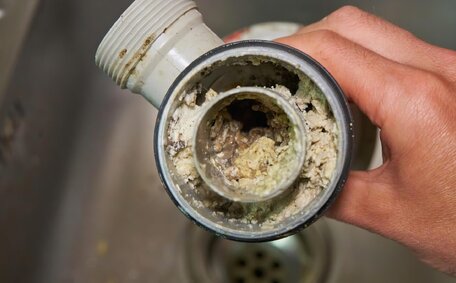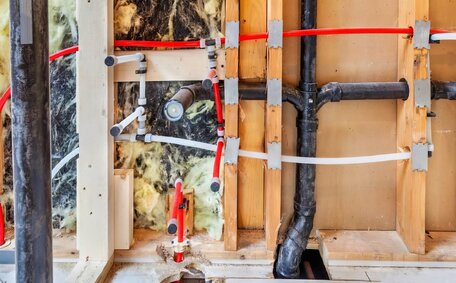Introduction to Septic Systems
A septic system is an onsite wastewater treatment solution commonly used in rural areas or large properties where connection to main sewer lines is not viable. It consists of two main components - the septic tank and the drain field (also called a leach field or soil absorption field).
The septic tank is a buried, water-tight container usually made of concrete, fibreglass or polyethylene. It holds the wastewater from your home so solids can settle out and partial treatment can occur. The liquid effluent then flows from the tank to the drain field.
The drain field has a network of perforated pipes laid in gravel trenches over an absorption bed.
Effluent percolates through soil, which provides further treatment through biological action. Septic systems effectively remove many contaminants and pathogens. Proper maintenance is crucial for effective operation.
When correctly installed and maintained, septic systems offer an effective long-term solution for managing wastewater and protecting the environment. Checking for signs of failure and getting your tank pumped regularly by a professional is important.
How Septic Tanks Work
Septic tanks are designed to provide preliminary treatment of wastewater by separating solids from liquid effluent. This allows much of the suspended solids to be removed before the effluent is dispersed to the drain field.
When wastewater enters the tank, solids settle to the bottom forming a sludge layer while grease and oils float to the top creating a scum layer.
The wastewater enters the first chamber of the septic tank through an inlet pipe. The lighter solids and oils float to the top. Most tanks have two chambers or compartments separated by a wall or baffle.
Baffles and screens help slow the flow so the heaviest solids can sink to the bottom. Baffles and screens help slow the flow so the heaviest solids can sink to the bottom.
In the second chamber, floating scum is retained by an outlet tee or baffle. The clarified liquid (effluent) exits the tank through the outlet pipe and travels to the drain field for further treatment and dispersal into the soil. Over time, sludge builds up and must be pumped out periodically by a professional.
Proper wastewater separation and retention time in the septic tank allows solids, greases, and oils to decompose naturally and prevents them from entering and clogging the drain field. Routine septic tank pumping and inspection helps keep the entire system working efficiently.
Signs Your Septic Tank Needs Service
There are several clear signs indicating your septic tank needs immediate service by a professional:
Slow Draining
If sinks, showers and toilets are draining slowly, this often means the septic tank is full and unable to accept wastewater at its normal rate. Solids may be backing up and blocking the inlet.
Gurgling Sounds
You may hear gurgling coming from plumbing fixtures, or even see bubbles in the toilet bowl. This indicates a septic tank that’s become overloaded with wastewater.
Sewage Odours
Foul odours around the septic tank or inside the home suggest the septic system is not functioning properly. Solids may have built up in the tank or plumbing.
Pooling Water
Standing water or muddy soil around the septic tank or drain field can signify a system backup. The drain field may be clogged or overloaded with effluent.
Bright Green Grass
Lush, bright green grass over the drain field while the rest of the lawn is normal may indicate excess nutrients from wastewater reaching the surface. This is a major red flag.
If you notice any of these issues, arrange for your septic tank to be pumped and inspected immediately to prevent damage. Regular septic service and maintenance is the best way to avoid serious problems down the line.
Slow or Clogged Drains
Slow draining from sinks, tubs, showers or toilets is one of the most common signs your septic system needs attention. When drains back up or are sluggish, it indicates the septic tank is failing to accept wastewater at the normal rate.
This usually means the septic tank is overloaded and needs to be pumped. Excess solid waste has built up inside the tank, reducing its wastewater capacity. Solids may also be obstructing pipes or orifices, restricting flow.
In a worst case scenario, wastewater could be backing up into the home because the tank is completely full. Slow drainage means effluent cannot flow normally to the drain field for treatment and dispersal.
Clogged drains may also be accompanied by gurgling sounds as air pockets form in the plumbing system. Bubbling out of the toilet bowl can occur too. Standing water around drain fixtures is another sign of blockages.
Professionals should be called immediately if drains are slow or clogged. Any clogged piping will also need to be cleared. Ignoring slow drains can lead to sewage backups, expensive damage and environmental contamination.
The septic tank needs to be pumped, inspected and checked for any leaks or damage.
Sewage Odors
Unpleasant sewage odours around your home or septic tank area are a telltale sign of problems. This noxious smell indicates wastewater is backing up somewhere in the system.
Sewage gases like hydrogen sulphide, methane and ammonia produce foul rotten egg, stale urine or decaying organic matter odours. They are released when wastewater accumulates and lacks sufficient oxygen to decompose properly.
Common causes of sewage odours from a septic system include:
- A full septic tank - Excess solids have built up requiring pumping.
- Clogged plumbing - Blockages in pipes or orifices, preventing wastewater flow.
- Failed drain field - Wastewater surfacing and unable to percolate into soil.
- Improperly vented plumbing - Gases cannot escape through vent pipes.
- Cracked septic tank - Allows gases to escape into soil.
Septic odours are more than just unpleasant. Methane and hydrogen sulphide gases are highly flammable and dangerous. Foul smells entering the home also pose health risks.
If you notice sewage odours, take immediate action by contacting a professional plumber to inspect the septic tank and drain field for problems. Proper maintenance helps prevent bad odours and serious septic issues.
Standing Water Around the Drain Field
Standing water or soggy soil around the drain field can be a major red flag for septic tank troubles. This indicates wastewater is unable to properly percolate down through the soil.
When water pools on the surface, it means the drain field is saturated. Liquid effluent cannot infiltrate into the ground anymore. This backing up occurs when the field receives more wastewater than it can handle.
Common causes include:
- Excess wastewater flow - More water entering than the system was designed for.
- Clogged piping - Solids blocking distribution pipes.
- Compacted soil - Heavy machinery driven over field.
- Tree roots - Root masses prevent water percolation.
- Flooding - High water table saturates field.
Standing water provides a breeding ground for harmful bacteria, viruses and mosquitoes. Effluent will not get properly treated and can contaminate groundwater. Expensive repairs to the drain field may be needed.
This visible pooling requires urgent professional servicing. The septic tank will need pumping and inspection. Ensuring proper wastewater disposal prevents damage and health hazards.
Any clogs must be cleared from the distribution piping in the drain field.
Unusually Lush Grass Over the Drain Field
One of the clearest visual signs that your septic tank has an issue is seeing patches of unusually lush, bright green grass growing above the drain field area, while the surrounding lawn looks normal. This vibrant green patch is caused by an overload of nutrients from wastewater effluent reaching the surface.
This occurs when the drain field becomes saturated and unable to adequately absorb and filter the liquid waste. Excess nitrogen and phosphorus from the effluent acts as a fertiliser, causing the grass to thrive while the rest of the lawn lacks this nutrient boost.
Having lush grass surrounding the drain field is not normal and signifies the tank urgently needs professional servicing. The septic system is backed up and continuing to send effluent into a drain field that cannot handle it. This will damage the field and lead to costly repairs if left unaddressed.
Getting the tank pumped immediately is crucial to prevent clogging and further overload. A thorough inspection of the baffles, pipes and drainage trench will indicate any damage that needs repair. Lush grass growth on the surface can be reversed once wastewater flows normally again through a working system.
Gurgling Sounds from Pipes
Hearing gurgling noises coming from your household pipes and plumbing fixtures can be a telltale sign that your septic tank needs servicing. This audible gurgling occurs when wastewater cannot flow properly through the inlet or outlet pipes, causing air pockets and turbulence.
As solids accumulate and wastewater backs up in the septic tank, it displaces the air inside the plumbing system. The result is bubbling, churning and gurgling sounds as the air escapes up through the pipes and drains.
Gurgling noises are most noticeable coming from sink, bathtub and shower drains. You may even see bubbling in the toilet bowl as gases are released. The sounds tend to be loudest when wastewater is flowing.
The gurgling indicates the septic tank is becoming overloaded and failing to accept wastewater at its normal pace. Urgent pumping is required to remove excess sludge and restore proper function. It also allows blockages causing the gurgling to be identified and cleared.
Left unchecked, wastewater can back up into the home or clog the drain field. Gurgling pipes are the septic system’s cry for help, so immediate professional attention is needed to prevent damage and avoid health hazards.
Sewage Backing Up
One of the most serious signs your septic tank needs immediate servicing is sewage actually backing up into the home. This occurs when the tank is completely full and unable to accept any more wastewater.
Effluent and solids will begin coming back up through the inlet pipe and overflowing sinks, bathtubs, showers and drains. You may see sewage pooling on the ground around tank access points or manholes. An overpowering rotten stench will accompany the backups.
This is an emergency situation and professionals should be called right away. Toilets should not be flushed to prevent further backups. The septic tank will need pumping, a full system inspection and any clogs rapidly cleared.
All wastewater sources must be stopped.
Sewage backups threaten health through disease transmission and contamination. The home may sustain major water damage if left unchecked. Regular septic tank maintenance helps avoid backups, but rapid response is key if they unfortunately occur.
When to Call a Professional
Calling a professional septic tank pumping service is recommended when you notice any of the signs mentioned. Slow drainage, sewage odours, gurgling pipes, and wet areas around your tank all indicate it’s time to take action.
It’s especially important to call right away if you experience sewage backing up into your home. This dangerous situation allows disease-causing pathogens to spread and can cause severe property damage.
Professionals have the equipment and expertise to pump out your tank, clear clogs, perform needed repairs, and get your septic system working properly again. Preventing backups and overflows avoids contamination of soil and groundwater.
Regular septic tank maintenance can help avoid most major issues. Experts suggest getting your tank pumped and inspected every 3-5 years. Systems with heavier use may need more frequent service.
Take notice if you experience any of the warning signs between routine cleanings.
Calling at the first signs of trouble provides peace of mind that your system will keep working safely and prevent the need for costly emergency repairs down the line. Don’t hesitate to pick up the phone – the health of your family and home depends on it.
Regular Maintenance
Having your septic tank professionally pumped and inspected every 3-5 years is crucial to maximise its lifespan and prevent major issues. Regular maintenance helps the system function efficiently and avoid the warning signs outlined.
Over time, solids accumulate in the tank and need to be removed. A professional will pump out these solids along with the scum layer. They will also check tank components like baffles, tees, lids and vents for damage and perform any needed repairs.
Inspections help identify potential problems before they lead to total failure. Technicians will check the drain field for signs it is clogged or overloaded. They can determine if excess water usage is overtaxing the system.
Routine septic service improves safety by preventing contamination of groundwater from leaks, overflows or backups. It also reduces the need for costly emergency repairs.
Regular pumping and inspection provides peace of mind your system is working properly and safely. This routine maintenance helps maximise septic system lifespan, keeping your home and the environment protected.
How Often to Pump Your Septic Tank
Septic tanks should typically be pumped every 3-5 years to maintain proper function and prevent problems. However, there are several factors that can influence pumping frequency:
- Household size - The more people using the system, the quicker solids will accumulate.
- Water usage - Excessive water flows require more frequent pumping.
- Tank size - Smaller tanks fill faster and need earlier pumping.
- Garbage disposal use - Grinding food waste increases solids accumulation.
Inspecting the sludge and scum levels annually can help determine your ideal pumping schedule. Usage patterns and tank maintenance history should also guide your cleaning frequency. When in doubt, err on the side of caution with more frequent pumping.
Extending the Life of Your Septic System
There are several steps homeowners can take to extend the lifespan of their septic system and avoid costly repairs down the road:
- Have the tank pumped every 3-5 years by a professional. Regular maintenance removes excess solids and prevents clogging.
- Use water efficiently - fix leaks, upgrade toilets/faucets and avoid straining the system with too much flow.
- Protect the drain field by not driving vehicles over it or building structures on top of it.
- Avoid flushing harmful chemicals, pharmaceuticals and non-biodegradable products that can damage the system.
- Limit use of a garbage disposal as this adds extra solids to the tank.
- Keep accurate records of septic service and repairs for future homeowners.
- Do not plant trees or shrubs near the drain field as their roots can damage and clog pipes.
- Divert stormwater drainage and rain gutters away from the septic system.
Regular maintenance paired with protective care of your septic system is key to ensuring it works properly for decades. Contact the professionals at Peakhurst Plumbing to get on a regular septic service schedule.






